More than a decade ago, Dropbox brought home the benefits of cloud storage to everyday users by allowing them to save files in the cloud instead of their PCs. Within no time, users have got used to accessing and sharing files from cloud storage wherever they are, from laptops, tablets and phones. In fact, most end users have the bulk of their data in the cloud today.
Enterprises were initially reluctant to follow suit because:
Enterprises run mission-critical apps that can’t be run on any non-scalable device or infrastructure. They have built and maintained modern data centers for the sole purpose of keeping these apps running.
There are serious security risks to storing personal data of consumers and employees. In many cases, stringent regulations require enterprises to have some sort of on-premise model to store data.
To get around these significant concerns, enterprises have adopted a hybrid cloud model in place of the public cloud to simplify data management and mine the big (and scary) data streaming through their servers.
The 101s: What Exactly Does Hybrid Cloud Storage Involve?
The hybrid cloud approach to managing storage entails both on-premises (private cloud) and off-premises (public cloud) infrastructure. More often than not, enterprises supplement frequently-used data on internal storage systems by putting archived or inactive data, or information for the general audience on the public cloud.
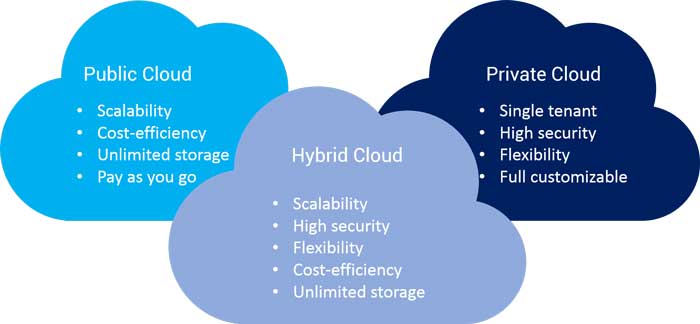
Source: Alibaba Cloud
This implementation is transparent and appears homogenous to users at all access levels. The interface is usually managed using proprietary or commercially available software. The hardware infrastructure consists of cloud storage appliances that reside in the organization’s datacenter and serve as a gateway between the on-premises and public clouds.
1. Cost Savings
Easily the biggest benefit for enterprises, hybrid cloud storage is a great improvement over the expensive storage arrays needed to maintain data and workflows in a private cloud. A hierarchical storage management policy ensures data is moved to the cheap, pay-as-you-go public cloud as it ages, loses value or relevance, and is accessed with decreasing frequency.
Additionally, both the direct cost and speed of backups and recovery are made simpler with tiered storage, offering more opportunities to save on hardware costs.
2. No-limit Scalability
In the enterprise, there is potentially no limit to the workflow or data operations that can be scaled with a hybrid cloud deployment. It leverages the computing capabilities of the organization’s datacenter for business-critical data, and adds the flexibility and space of the public cloud for file storage and demand spikes.
How? Storage is not just limited to data blocks. There needs to be a matching increase in performance capabilities. Enterprise consumers are already pushing exabyte capacities. While public clouds can scale for this, workflows and applications now need hundreds of gigabytes and millions of IOPS (input/output operations per second) to keep operations going.
Hybrid cloud implementations provide for this infrastructure agility with rapid deployment, commissioning and de-commissioning of storage and file system elements as per the requirements of each application.
3. Need for Speed
Performance and speed go hand in hand. Mission-critical workloads that have low tolerance limits on data latency are not suitable for the public cloud, but those can be managed by the private, on-premises infrastructure that enterprises already have in place, or can upgrade to easily.
Hybrid cloud deployments are API-driven and allow for speed and productivity improvements in development. Enterprises usually opt for a lift-and-shift model of deployment or migration, using which they can seamlessly continue their operations, reduce the time to solution significantly, and speed up innovation by rapidly developing and deploying new apps.
4. Ideal Infrastructure and Ecosystem for Enterprise Applications
That brings us to the primary applications of hybrid cloud storage, along with new services and new apps that are born in the cloud itself, and generate a lot of data from Day 1. However, these applications don’t exist in a vacuum – they need a whole ecosystem of processes, services, and infrastructure to support them.
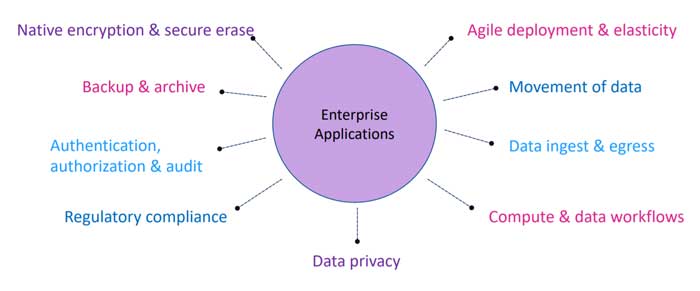
Source: Storage Networking Industry Association
In order to manage this ecosystem, the copybook infrastructure for enterprises would be a combination (or hyperconvergence) of scale-out clusters of high-performance servers and data locality (local storage of data). A hybrid cloud platform simplifies deployment of this underlying infrastructure with a unified data management plane and the use of “containers” (software that virtually packages and isolates applications for deployment by sharing access to OS kernels without the traditional need for virtual machines). Storage controllers are virtualized and provide access to block distributed data, files, and objects separately to each application.
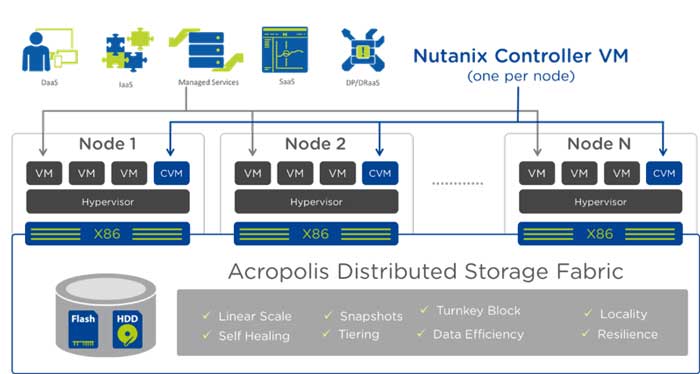
A well-configured enterprise hybrid cloud deployment would involve a distributed storage fabric that virtualizes local storage from multiples and disparate nodes in a cluster into a unified pool. The storage component of a hyperconverged infrastructure uses software to make disparate commodity or legacy hardware systems work together and non-disruptively deploy essential features such as:
Auto tiering: Hot data is stored in flash while cold data is stored in SSD or HDD arrays across clouds or clusters. Data is automatically moved between tiers based on access patterns. Includes auto archiving.
Auto tuning: Performance tuning happens continuously on random or sequential I/O even when multiple workloads are running simultaneously.
Auto leveling: Algorithms ensure that data is balanced across clouds and can use storage from other nodes as needed, optimizing for capacity and loads.
5. Unified Interface for Administration
A plethora of applications and complex mix of algorithms only serves to increase complexity in data and systems management. Automating and managing workflows between the private and public clouds, between different public cloud deployments, or even within the datacenter is riddled with pitfalls. In order to centralize governance and administration, IT needs to ensure that
Enterprise policies are applied across all storage systems and devices.
Required data is available as and when needed with appropriate access levels and security controls in place.
Files or objects are delivered across multiple protocols to all workloads and users.
Compute workflows, services, and analytics are operating in the background as configured.
The need of the hour, therefore, is a single software-based management platform across datacenters, branch offices, or the cloud. Monitoring and managing systems in private or public clouds usually involves a multi-tool, native approach. A hybrid cloud model makes available a non-native but unifying tool to help enterprise admins govern multiple platforms, services, resources via a ‘single pane of glass’ interface.
This is done by placing an abstraction layer between the multi-cloud architecture and the combination of private and public clouds and disparate internal systems.
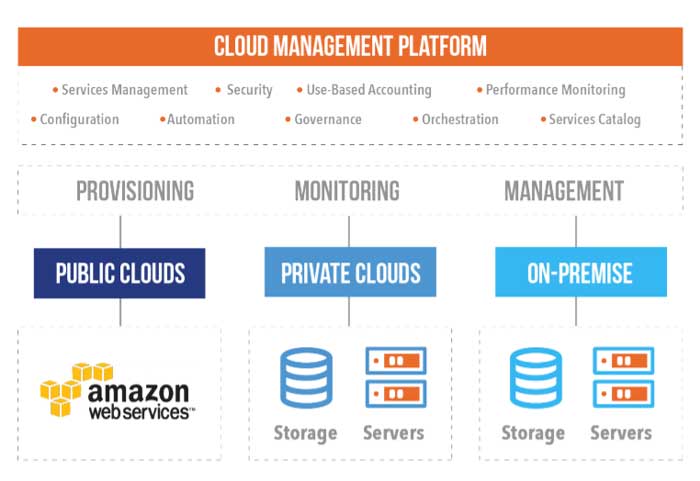
Source: GigaOm Hybrid & Multicloud Complexity Whitepaper
Thus, the hybrid cloud provides the enterprise a simple way of provisioning across heterogenous information systems as well as different clouds that the organization might be using for data, compute, and storage operations. This allows the enterprise to stick to certain data management and storage fundamentals:
Data virtualization: Applications and users retrieve and manipulate data without requiring technical or meta details on where it is located, how it is formatted, etc.
Data gravity: Data, records, or files aren't moved unless absolutely necessary. Workloads are pushed to where data is stored.
Copies of data are minimized to bare necessities and entropy is eliminated. A single ‘source of truth’ is available across the enterprise.
6. Low-Impact Risk Management and Disaster Recovery
The ability to store, manage, and port data between on-premises and the cloud minimizes business impact of failures of any size – be it a single array or throughout a geographical site. Properly configured hybrid cloud setups give users continued access to critical applications and data even when mishaps strike an external cloud provider or internal systems.
A Gartner survey found that 80% enterprises faced an incident in the past two years that required an IT-based disaster recovery plan. In the enterprise, unplanned downtime that results in longer recovery times or unrecoverable data quickly adds up to lost revenue,
No surprise then that cloud-based recovery is IT’s preferred choice for DR of critical infrastructure and services, especially as 37% of organizations target the restoration of mission-critical processes in less than an hour, as per the Gartner findings.
Disaster recovery is now part of the traditional IT model out in the cloud, enabling the setup of multiple high availability zones in the cloud that are replicated and synced bidirectionally with master datasets.
A hybrid cloud facilitates replication of critical data across nodes and clusters on private and public clouds for better protection and availability. These clusters can be self-healing; when a disk or node fails, full data redundancy is quickly and automatically restored to protect against additional failures. By architecting a big data application such as Hadoop to span multiple clusters, even a full rack failure can be sustained without interrupting operations.
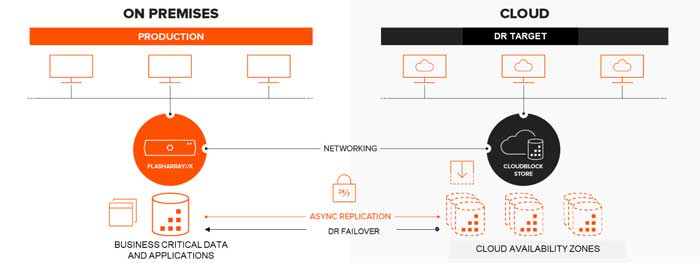
Source: Pure Storage
Additionally, cloud backup services (replication is not backup) come with higher levels of reliability, lower costs, and quicker restore times. With a hybrid cloud model, enterprises aren’t paying for a system that just sits there waiting for something bad to happen.
7. All Encompassing Security and Privacy
There are other concerns in the enterprise beyond immediate protection and recovery-related pitfalls. One of them is that employees often store data in the public cloud, which may potentially lead to standards or compliance issues.
Ensuring and maintaining cloud security compliance in the enterprise is all about alignment. The enterprise's security policies, standards, and procedures must align with its public cloud’s or managed service provider's security capabilities. Although all major public cloud providers offer very good encryption, authentication and other security controls to keep business and consumer data safe, there is a steep learning and implementation curve for enterprises as they use multiple clouds, each with its own set of security configurations.
“The public cloud doesn't secure your applications for you,” said Mike Wronski, Director of Product Marketing at Nutanix. “The providers secure their infrastructure, but they don't ensure that the services are implemented securely. They leave that up to the customer,” he added.
Further, the data types themselves (especially in health and finance) could be regulated by agencies and authorities and governed by privacy acts, requiring businesses to store certain data in a private cloud or on-premises. Now that data privacy is at the forefront of customers’ requirements and storage solutions need to stop treating it as an afterthought.
Hybrid cloud implementations offer the best of both worlds with secure integration and additional layers of security between private and public clouds. Enterprise cloud platforms such as Nutanix’s have in-built controls, encryption and immutability features to restrict access to sensitive data, mask personal identifiable information (PII), detect and flag anomalies, and deflect suspicious activity from either internal systems or public clouds.
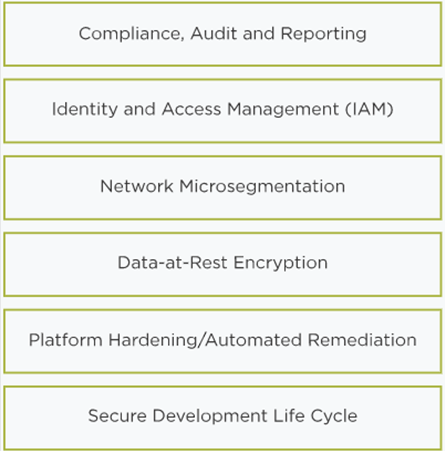
Business Continuity with Persistence
The hybrid cloud is a great catalyst for innovation – by extending security, manageability and control capabilities to the public cloud’s scalability, it has redefined storage “as a service.” IT departments can quickly develop new apps, APIs, and test new instances and capabilities without worrying about resource limitations, lending more agility and flexibility to business processes. This blurs the line between primary and secondary storage use cases.
“When we’re talking about strategies for the hybrid cloud, it’s not just looking at the point solutions for archive, disaster recovery or new services. It's about the persistent storage that you need to have to move back and forth between these environments,” summed up Douglas O’Flaherty, Director of Storage Marketing at IBM.
When organizations don’t have to worry about constraints on data collection or storage, they get better at analysis, application, and strategy. Hybrid cloud has rendered the questions of how to gather data and where to store it redundant. The enterprise now has at its disposal scalable, reliable technologies that helps it get real value out of data.
Featured Image: Pixabay
Dipti Parmar is a marketing consultant and contributing writer to Nutanix. She writes columns on major tech and business publications such as IDG’s CIO.com, CMO.com, Entrepreneur Mag and Inc. Follow her on Twitter @dipTparmar or connect with her on LinkedIn.
© 2020 Nutanix, Inc. All rights reserved. For additional legal information, please go here.

